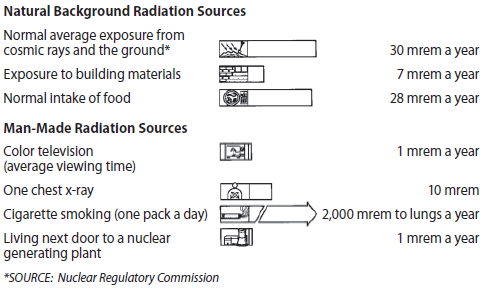Radiation is a form of energy. It comes from radioactive elements, natural and man-made, whose atoms are unstable. Radiation has been around since the beginning of time.
Radiation is all around us. It is in the air we breathe, the food we eat, and the water we drink. It is in our homes and even in our bodies. This is called natural or background radiation.
In addition to background radiation, there is also man-made radiation. It comes from such things as medical and dental x-rays, color televisions, smoke detectors and some watches with dials that glow in the dark. Very small amounts of radiation come from nuclear power plants.
Radiation is measured in units called millirems. A millirem is a unit used to measure radiation dose to humans. The drawing below shows how much radiation we get from different things.
For radiation to cause any measurable biological effect in human beings, most scientists agree that the exposure must reach about 25,000 millirems – in a single, short-time exposure.
Federal standards drawn up and enforced by the Nuclear Regulatory Commission (NRC) require that workers at nuclear power plants receive no more than 5,000 millirems of radiation a year.
Average radiation exposure levels in millirem (mrem)

